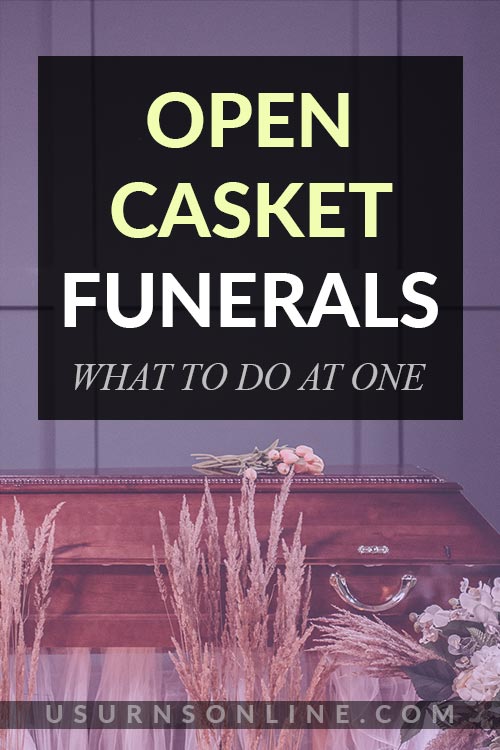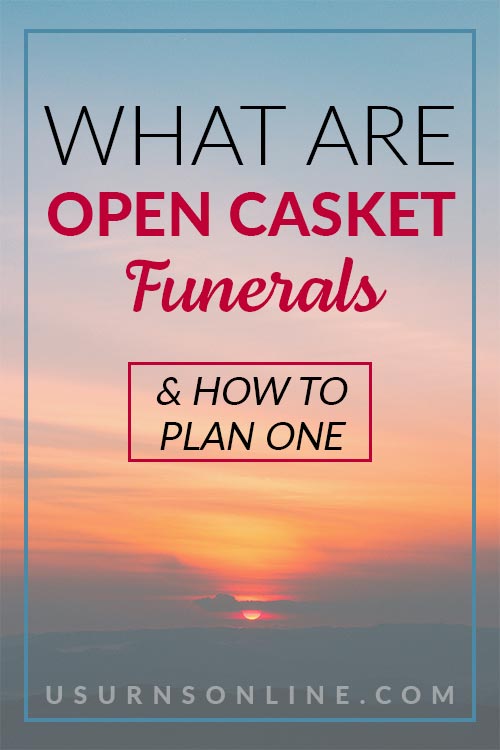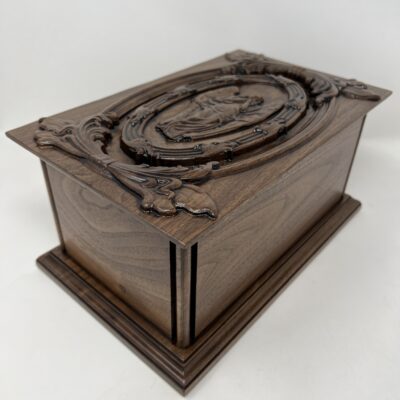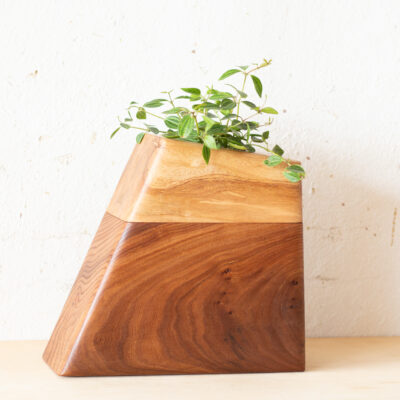“Will this be an open casket funeral, or closed?” This is one question the funeral director will be sure to ask during the funeral arrangements.
As you consider how to answer, there are a few additional questions you will need to ask yourself.
Knowing the last wishes of the deceased would be ideal, but what if you don’t know? How do you decide between an open or a closed casket service?
Or perhaps you are attending a funeral, and you are concerned about what it will be like to see or be near the deceased with them visible in the casket.
Continue reading to learn everything you need to know about open casket funerals.
Our website is supported by our users. We sometimes earn a commission when you click through the affiliate links on our website. See our privacy policy & disclosures for more information.
What Is an Open Casket Funeral?
An open casket funeral is a traditional funeral service in which the coffin or casket is open for mourners to view the body of the loved one one final time.
Embalming is typically done, along with hair, makeup, and clothing so that the decedent resembles what they looked while alive.
Advantages of open-casket funerals
- Everyone can say their final “goodbye.”
- Allows friends and family members to kiss the deceased goodbye one last time.
- The family can hold the decedent’s hand.
- Everyone can take comfort in seeing the deceased looking beautiful and at peace.
What Is a Closed Casket Funeral?
At a closed casket funeral, the casket is closed and will remain closed. The body will not be shown throughout the funeral service. Therefore, no one is going to see the body of the deceased.
Reasons to choose a closed casket funeral
- The decedent died a violent death and is not viewable.
- Instead, the surviving family wants to remember them “as they were in life.” Often, a large photo or poster board is displayed near the casket for this purpose.
- Seeing a loved one that is deceased may be traumatic to children.
- In addition, some religions are against an open casket.
- Some people are simply not comfortable with the idea of an open casket service.
What to Expect at an Open Casket Service
The open casket will usually be at the chapel’s front, and the body will be dressed and made up, giving it a life-like appearance.
Urns Made in the USA
If you prefer not to view the open casket, walk past without looking or take a seat without passing by the decedent. No rules say you must look.
It is important to know that the body will look different than how the person looked while alive. Therefore, be prepared for the emotions you may feel upon viewing the deceased.
This can be a very difficult time, and it is common to have an emotional experience. If you don’t want to view alone, take a close friend with you to view the casket.
It is never appropriate to try to embrace the body. It is ok to give a gentle kiss on the cheek or touch on the hand. Keep in mind though that the deceased’s body will feel cold and hard to the touch.
Prepare your children to attend the viewing. Most kids have never seen a dead body. Let your child know that if they don’t feel comfortable being close to the body, it is ok to stand further away.
Open or Closed Casket: Which to Choose?
If you are planning a funeral, here are some considerations to help you decide on open or closed casket.
1. Sense of Closure
Some people find it consoling to have a sense of closure with the deceased. An open casket can offer a chance for some measure of resolution in the midst of the grieving process.
You can have that last look, final kiss, or whisper something in your loved one’s ear. Family members and friends like to place mementos in an open casket. It’s comforting to put a personal item with your loved one.
In essence, seeing the body helps mourners face the fact that the death has occurred. They know that their loved one is not suffering or in pain anymore, and seeing them “at rest” makes that a reality.
In addition, some mourners report that viewing the open casket helps them begin healing.
2. Condition of the Body
The cause of death is a major consideration. Closed caskets are better if someone passed away from an accident or illness that caused changes in their appearance.
For example, a head wound or sickness that caused extreme emaciation might be the reason for a closed casket. The funeral director will advise you when this might apply to your loved one’s funeral. Be prepared to follow the funeral home staff advice in this matter.
3. Death and Emotional Triggers
As a personal preference, you may not want to view the body at the funeral. This could be due to a variety of reasons:
- An unsettling feeling you get around the body
- You want to remember your loved one as they were in life
- A concern that seeing your loved one at the funeral may be too overwhelming
- Similar sights have been emotional triggers to past trauma
Whatever the reason, if you don’t want to have an open casket, you’re free to choose a closed-casket funeral. That is perfectly acceptable.
Death is difficult for everyone. Some people handle it differently, and that is ok.
4. Children
Suppose there will be many children and teens attending the funeral. In that case, an open casket could be a shocking experience for them. This is a valid concern.
The flip side is the view that death is a “normal” part of human existence. Some people believe that therefore we should not shelter people (even young ones) from death, but rather accept it and engage with the (often difficult) emotions rather than hiding or trying to subdue them.
In this perspective, if a child is old enough to understand death, they should be told about it and allowed to participate in the funeral and memorial events.
This can include an open casket and seeing the deceased’s body. It may be unsettling, since our culture is not used to dealing with death up close, but sometimes facing a little discomfort head-on is better than creating a taboo that results in an inability to cope in a healthy way.
5. Your Loved One’s Wishes
Finally, you have to consider what your loved one would have liked best. Did they express a preference? I think it’s always best to follow the deceased’s wishes.
How to Plan an Open Casket Funeral Service
You will be asked if you want an open or closed casket upon meeting with the funeral director. Your funeral director will advise you if the body is in viewable condition.
- When you choose the casket, always stay in your price range. Your director will show you a variety to pick from, and you can also order many of the same caskets online for lower costs.
- Bring in a nice outfit for your loved one. Make sure the clothing is clean. Please include underwear.
- Choose a date and time for the funeral. Remember, everything from the clergy to the cemetery has to sync up.
- Will you have a public viewing before the funeral service? If so, will you hold it at the funeral home or your church? Of course, including a viewing with the funeral will cost you extra. This may or may not be an expense you want to incur.
Keep in mind, the further out you schedule the funeral, the longer the body has to be “kept.” Therefore, you will want to have your service as quickly as possible. After all, you want your loved one to look their very best.
More info: Funeral Planning Guide
Attending Open-Casket Funerals
Attending an open casket funeral will require a few more rules of etiquette.
- Viewing the body is optional. If you’re not comfortable with seeing the body, you do not need to go in the viewing line.
- Try not to touch the body too much. Cosmetics have been applied, and you don’t want to rub any makeup off or get it on your clothing.
- Unfortunately, it is very common for the body to be touched and kissed. And because of this, the cosmetics have to be reapplied.
- It isn’t necessarily impolite to touch the body, but please keep in mind to be respectful at all times. This is to honor the family as well as the body of the decedent.
- Be gentle when you kiss or squeeze the decedent’s hand.
- Sometimes people’s curiosity gets the better of them. I have actually had to stop people from trying to remove a wax plug from a bullet wound. That is absolutely forbidden. So please, be kind and show utmost respect at all times.
- Ladies, wear pants or a longer skirt. No mini-skirts; I’ve seen too many women bend over the casket with a short skirt on. Just don’t.
- Give the grieving family space. Don’t spend all of your time at the casket.
- The processional will occur when the service is complete. The funeral attendees will be ushered out by walking past the open casket.
Open vs. Closed Casket FAQ
Here are a few things you may or may not know about an open or closed casket.
Are open casket funerals common?
Yes, open-casket funerals are a very common type of service. Many families choose to have an open casket during a funeral, a wake, a viewing, or a vigil.
What religions and traditions have open caskets?
In the United States, most Catholic and Protestant funerals have the casket open, at least for some portion of the service.
Both Buddhism and Hinduism allow open coffin funerals. Despite this, there are some regulations of custom and aesthetics.
In the Muslim tradition, the deceased is buried without embalming. Therefore, no open casket services are possible.
Can you have a closed casket viewing?
No. When the casket is closed, it will remain closed, which means no viewing will be allowed.
You can, however, have a closed-casket funeral with a separate viewing service in which the casket is open. See here for more information about viewings.
How long after death can you have an open casket?
The primary factor determining when an open casket funeral can be held depends on whether the body has been embalmed. Upon death, decomposition of the body begins right away.
When storing a body in proper refrigeration, it can be shown at an open casket funeral for approximately two to three days after death. However, most funeral homes recommend having the open-casket funeral within 24-hours of death. This is to ensure the body is acceptable for viewing.
And honestly, the funeral home probably won’t allow an open casket viewing to the public without embalming.
Related: How Long After Death Is a Funeral Held?
Why do they cover the legs in a casket?
There are essentially two types of caskets: Half couch, or full couch. A half-couch casket is the most common type of casket available in most parts of the world today.
The lid of a half-couch casket is made of two separate pieces. That is the defining feature of a half-couch casket: the top half opens, and the lower half remains closed. This type of casket allows the top half of the person’s body to be shown while covering the bottom half.
Some families choose full-couch caskets. These caskets have a single, undivided lid that opens to reveal the entire body of the deceased. Full couch caskets are relatively uncommon.
Why is the head always to the left in a casket?
The caskets are hinged this way, for starters. But it is a tradition to have the head of the body facing the east; the east-facing placement has religious reasoning.
Matthew 24:27: “For as the lightning comes from the east and flashes to the west, so also will the coming of the Son of Man be…” thus for the Christian believer in the resurrection of the dead, placing the body facing east will allow the dead to see the Second Coming of Jesus.
Read next: The Complete Guide to Burial Caskets
It can be a personal decision, the decedent’s decision, or perhaps a religious one to have an open or closed casket. In the end, you have to make your decision using your best judgment.
Continue browsing our many articles for more information about funerals. We have an excellent Funeral Planning Guide along with an extensive FAQ section. You can contact us with additional questions.





